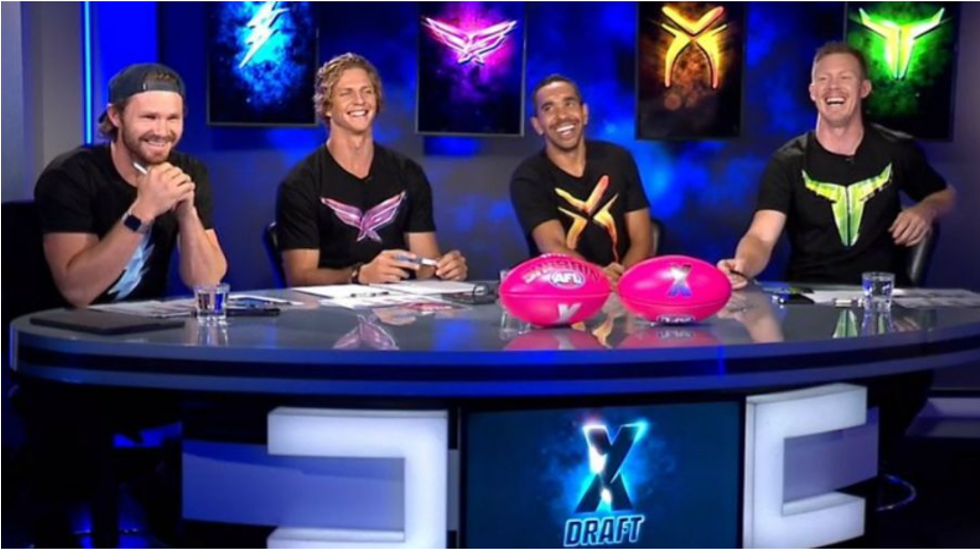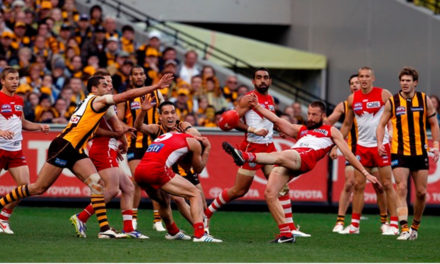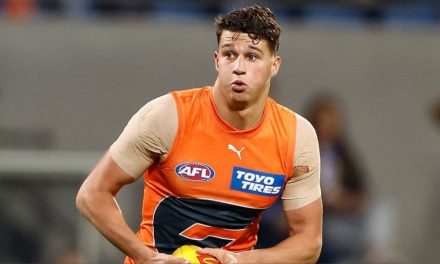Patrick Dangerfield, Nat Fyfe, Eddie Betts and Jack Riewoldt during last week’s televised AFLX “draft”. Photo: AFL MEDIA
This isn’t the United States. And these days, for obvious reasons, that fact alone might well be cause for much relief.
The differences between Australia and the US culturally might have narrowed over the decades, but they’re still substantial enough, particularly when it comes to sport.
That, however, doesn’t seem to stop repeated ham-fisted attempts to appropriate American sporting trends and mannerisms in our own sporting predilections.
If the whole AFLX concept wasn’t already making you cringe with its cartoonish team names (Bolts, Flyers, Deadlys and Rampage) and superhero-ish uniforms and graphic design, coincidentally (or not) just as Marvel have taking over naming rights for the AFL’s own stadium, the latest news about the tournament on February 22 might have.
It was the breathless announcement that “players have been encouraged to express their own personalities and bring flair to the game with an open dress code designed to enhance the excitement around the one-night event”.
That’s not on the field, in case you’re confused. That’s simply arriving at Marvel Stadium on the night. Excited enough yet? But wait, there was more.
“The initiative could see players wearing outlandish and/or suave looking outfits in an attempt to replicate their NBA and NFL counterparts,” said the article on the AFL’s website, accompanied by various pictures of multi-millionaire US sports stars dressed in orange or purple suits and sporting fedoras etc, etc.
Before we even discuss the fact Australian sportsmen don’t tend to dress like cashed-up pimps on Hollywood’s Sunset Boulevard, there’s a logistical issue here. Players at Marvel Stadium park underneath the ground and walk to the dressing rooms not on a catwalk, but an enclosed space in which perhaps only their teammates, officials and opponents will see them.
So even if we see this directive as a bit of harmless fun, for whose benefit will it actually be? Perhaps that of Instagram, the social media platform on which the pseudo fashion show will no doubt be primarily viewed.
But wasn’t AFLX, as we keep being told, supposed to be all about the kids? Will this lead children to nag their parents not for a Richmond or Collingwood jumper, but a Burberry or Gucci suit?
Either way, it’s more cringeworthy stuff with as little connection to our sporting culture as is imaginable. And seems to be another example of the AFL’s on-going failures to “read the room”. Take those same social media platforms, for example.
The drip feed of information about AFLX, from the revamp of the concept itself, to the team names, uniforms, last week’s televised “draft”, complete with “steal” cards, then the “dress to impress” invitation, has simply meant the league has copped several barrel loads of flak instead of just one.
It says a lot about how the footy public is viewing AFLX that a common reaction to the televised draft last Wednesday was that the banter between captains Patrick Dangerfield, Nat Fyfe, Eddie Betts and Jack Riewoldt was a lot more entertaining than anything to do with the actual games would be.
But the biggest flaw, surely, remains not “game changers” whose score contributions will count double, nor “launch zones” but the entire structure of the evening.
When AFLX was staged for the first time last year, it was also against a backdrop of cynicism, but even then fans knew that they could at least support their team when it was on, not an artificially created group of superstars about whom no-one will give a toss when it comes to the actual result.
One of the basic tenets of the depth of passion football fans have for their game is their connection to a club. When clubs are removed from the equation, all that’s left is a collection of star players aligned to meaningless teams in which is there literally no emotional investment.
Thinking that those interested in football, even the kids to whom AFLX is now clearly being pitched, will be just as interested in following individual players rather than clubs with a history and tradition, is a basic and massive error of judgement.
Club alignment is why fans stick around through the dark times, when their teams aren’t winning flags, but wooden spoons. Without it, the action we’re watching is little more than entertainment.
And how this version of AFLX comes across. An impressive parade of stars, but playing a game with only a tenuous connection to the real thing, and without any meaning attached.
I’m not sure the AFL has understood that sufficiently. And consequently has poured a decent amount of money into something which wasn’t wanted or needed, won’t be appreciated for anything more than novelty value, and which, at a most basic level, will be no different to watching a movie.
Perhaps the Americans might see it differently as they fawn over which star is wearing which designer as they walk into the change rooms. But in Australia, that’s not even how we do entertainment, let alone sport.
*This article first appeared at SPORTING NEWS












Couldn’t agree more Rohan. The only interest I have in AFLX is making sure none of my team’s players gets hurt before the real thing begins.
We have a uniquely Australian game with its own traditions and yet the suits seem only to be reading the NFL and NBA handbooks.